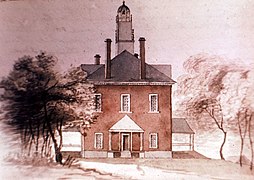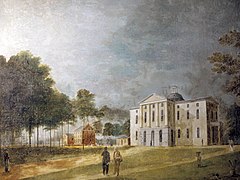
The Virginia State Capitol is the seat of state government of the Commonwealth of Virginia, located in Richmond, the third capital city of the U.S. state of Virginia. It houses the oldest elected legislative body in North America, the Virginia General Assembly, first established as the House of Burgesses in 1619.
Events from the year 1831 in art.

The North Carolina State Capitol is the former seat of the legislature of the U.S. state of North Carolina which housed all of the state's government until 1888. The Supreme Court and State Library moved into a separate building in 1888, and the General Assembly moved into the State Legislative Building in 1963. Today, the governor and his immediate staff occupy offices on the first floor of the Capitol.

The United States Capitol rotunda is the tall central rotunda of the United States Capitol in Washington, D.C. It has been described as the Capitol's "symbolic and physical heart". Built between 1818 and 1824, the rotunda is located below the Capitol dome, which was built between 1857 and 1866.
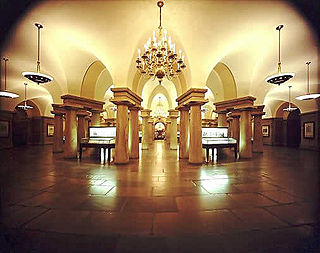
The United States Capitol crypt is the large circular room filled with forty neoclassical Doric columns directly beneath the United States Capitol rotunda. It was built originally to support the rotunda as well as offer an entrance to Washington's Tomb. It currently serves as a museum and a repository for thirteen statues of the National Statuary Hall Collection.

The Market House is a Market house and town hall in the center of Fayetteville, Cumberland County, North Carolina. It was built in 1838 on the site of the old state house and Town Hall which burned down in 1831. Fayetteville was the capital of North Carolina from 1789 to 1794.

The North Carolina State Legislative Building was opened in 1963 and is the current meeting place of the North Carolina General Assembly, the state legislature of the U.S. state of North Carolina.
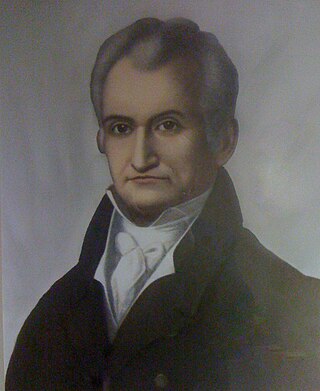
Colonel William Polk was a North Carolina banker, educational administrator, political leader, renowned Continental officer in the War for American Independence, and survivor of the 1777/1778 encampment at Valley Forge.

William Nichols, Sr. was an English-born architect who emigrated to the United States and became most famous for his early Neoclassical-style buildings in the American South. He designed statehouses for North Carolina, Alabama and Mississippi.
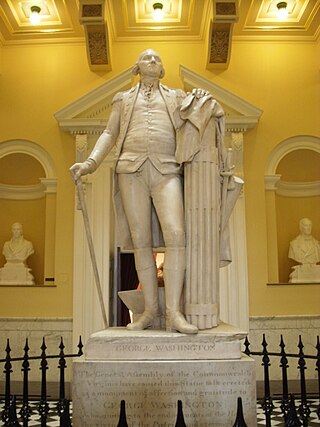
George Washington is a statue by the French sculptor Jean-Antoine Houdon from the late 18th century. Based on a life mask and other measurements of George Washington taken by Houdon, it is considered one of the most accurate depictions of the subject. The original sculpture is located in the rotunda of the Virginia State Capitol in Richmond, Virginia, and it has been copied extensively, with one copy standing in the United States Capitol Rotunda.

Henry Jackson Ellicott was an American sculptor and architectural sculptor, best known for his work on American Civil War monuments.
The following is a timeline of the history of the city of Raleigh, North Carolina, USA.

Market House Square District is a national historic district located at Fayetteville, Cumberland County, North Carolina. It encompasses 11 contributing buildings in the central business district of Fayetteville. The district includes six storefronts and a major store, an office building, a former Knights of Pythias Building, and the First Citizen's Bank Building, all of which date between 1884 and 1926 and ring the separately listed Market House. The First Citizen's Bank Building was designed by architect Charles C. Hartmann and built in 1926.

George Washington is a marble bust portrait of George Washington, done in the style of a Roman emperor, by the Italian sculptor Giuseppe Ceracchi. It was created as part of a campaign by Ceracchi to build a larger monument to Washington. The bust was thought by many to be one of the most lifelike. It was later used as a model of Washington for works by other sculptors and engravers.
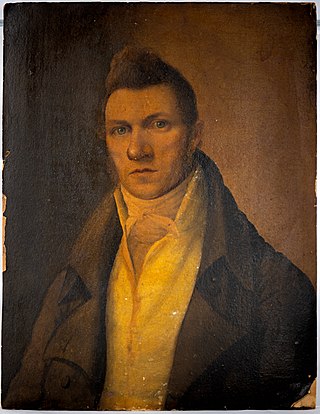
George Munger (1781–1825) was an early 19th-century American painter and engraver best known for watercolors of the White House and the U.S. Capitol after their burning by British troops in the War of 1812.
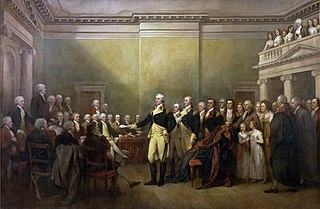
George Washington's resignation as commander-in-chief marked the end of Washington's military service in the American Revolutionary War and his return to civilian life at Mount Vernon.

George Washington was a life-size marble statue of George Washington, done in the style of a Roman general, by the Venetian-Italian Neoclassical sculptor Antonio Canova. Commissioned by the State of North Carolina in 1815, it was completed in 1820 and installed in the rotunda of the North Carolina State House on December 24, 1821. The building and the statue were destroyed by fire on June 21, 1831. This work was the only one created by Canova for the United States.
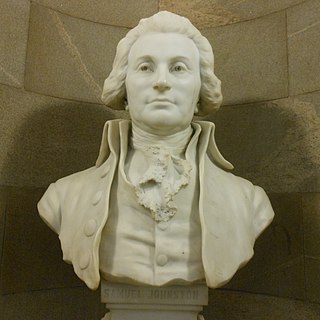
The Fayetteville Convention was a meeting by 271 delegates from North Carolina to ratify the US Constitution. Governor Samuel Johnston presided over the convention, which met in Fayetteville, North Carolina, from November 16 to 23, 1789 to debate on and decide on the ratification of the Constitution, which had recommended to the states by the Philadelphia Convention during the summer of 1787. The delegates ratified the Constitution by a vote of 194 to 77, thus making North Carolina the 12th state to ratify the constitution.
The Museo Canova is a museum established in 1833 at the birthplace of the Italian sculptor Antonio Canova (1757–1822) in Possagno in the province of Treviso in the Veneto, Italy. The museum is dedicated to the life and work of the sculptor and is composed of several parts.


